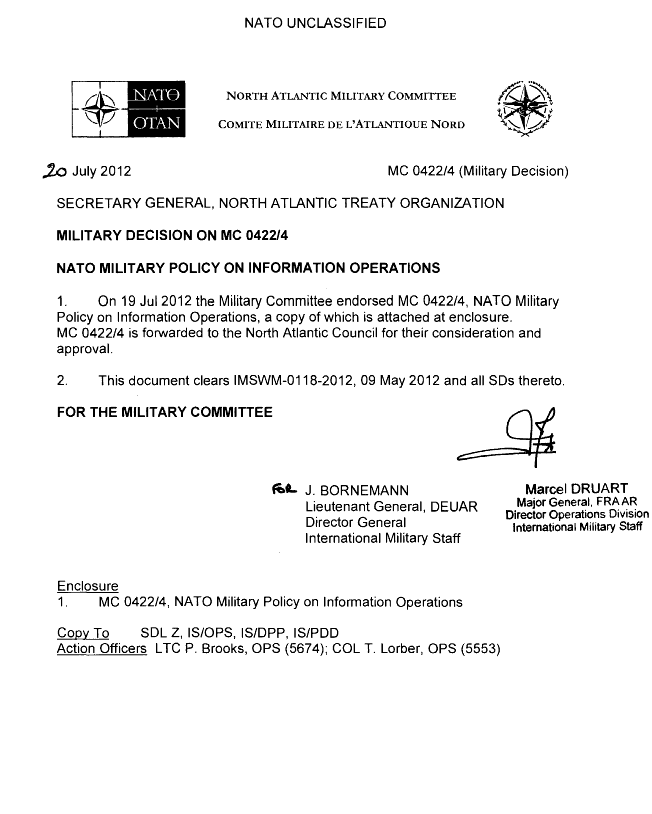The following is NATO’s military policy on information operations. Though unclassified, NATO doctrine documents are not released to the public.
NATO MILITARY POLICY ON INFORMATION OPERATIONS MC 0422/4
- 14 pages
- July 20, 2012
The Information Environment (IE) comprises the information itself, the individuals, organizations and systems that receive, process and convey the information, and the cognitive, virtual and physical space in which this occurs. This environment has seen significant changes in recent years. The importance of worldwide distributed information, the speed at which information is communicated, the role of social media and the reliability of information systems have created a situation in which no Alliance decision or action can be taken without considering its potential impact on the IE. The ubiquitous nature of information and the potential strategic ramifications of tactical actions add to the challenge faced by NATO Commanders. In this new IE it is more difficult to distinguish between the strategic, operational and tactical levels. The coordination, synchronisation and execution of information activities (IA) that deliberately create desired effects in the IE is essential to the Alliance’s successful functioning in peace, crisis and conflict.
Info Ops is a staff function to analyze, plan, assess and integrate activities focused on the IE rather than a capability in its own right. As a staff function, Info Ops provides the Commander with an assessment of the IE and a mechanism to plan and coordinate Information Activities on a continuous basis to achieve Information Effects in support of operational objectives.
At the Political-Military (Pol-Mil) level, the North Atlantic Council (NAC) and the Military Committee (MC), establish mission specific guidance, including StratCom guidance, to enable and maximize the effects of all information-related aspects of NATO’s operations and activities. Throughout the full spectrum of operations, peace, crisis and conflict, the integration and implementation of IA at every level of command is essential to overall success. The early application of IA can save resources, improve force protection and the effectiveness and efficiency of military capabilities through the establishment of planning and targeting priorities, and deconfliction and synchronization of activities.
…
The focus of Info Ops is on preserving and protecting alliance activities in the IE at all times while addressing, during military operations, NAC approved audiences, whose effectiveness is a function of their will, understanding and capabilities. As part of the operational and tactical planning, Info Ops plans, coordinates IA to reinforce or affect changes in behaviour, influence the will, shape perceptions, improve or degrade capabilities, and affect information and information systems.
Info Ops is comprised of three inter-related activity areas:
a. Preserve and protect Alliance freedom of manoeuvre in the IE at all times;
b. Induce, reinforce, influence, convince and encourage perceptions, attitudes and behaviours of NAC-approved audiences as part of NATO’s military missions;
c. Counter adversary’s propaganda as well as command functions and capabilities which support his opinion-forming and decision making processes.
…
Counter-Propaganda is a multidiscipline effort led and coordinated by Info Ops to analyse an adversary’s counter command and propaganda activities, to develop approaches and synchronize actions to counter these as appropriate. NATO PSYOPS forces and assets, supported by other functions, take a lead role in the analysis of adversary’s propaganda and support a variety of IA to counter it.

